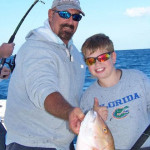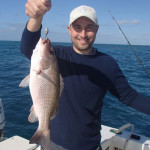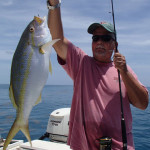May is traditionally the most active fishing month in the Lower Keys. There are more species overlapping in their availability this month than in any other. The list goes on and on, but whether fishing inshore, reef, wreck, or offshore, there are nonstop possibilities to be enjoyed.
For the fishing ADD afflicted like myself, this is quite the dilemma. There are not enough hours in the day to get in all of the fine fishing. Loading the boat for the proverbial bear every morning leaves us the flexibility to catch just about anything that comes along. On the way out of the channels, there are tarpon rolling on the calm mornings. It is just too painful to not stop, for at least a half hour, and put out some crabs or pinfish for the chance at hooking up with one of the truly great inshore game fish of the world.
Of course, if you hook up with one of these hundred plus pound herring, it will likely take you an extra hour to land it. And by the time the high fives are over, you will be overdue for your departure to the blue water. Time here for more decisions. Should you set up for some slow trolling right outside of the reef line, hoping for a chance at some sail fish action as they are heading north for the summer? Or, should you run straight offshore to get into the mahi mahi?
If you get hooked up on a sail, it gives you a chance at what I like to call the Aerial Slam. That’s putting a tarpon, a sail fish, and a dolphin into the air in one day. I don’t think you can find it in any of the record books, but it should be one of the choices for slam recognition.
On the rare day that the dolphin are not active, you can always go to the nearest deep water wreck and drop a line for one of the gut-wrenching fish to be found at depth – amberjack, almaco, African pompano, mutton snapper, and grouper. (Yes, soon it will be time for Keys residents to enjoy the taste of grouper again.) With the limit on amberjack down to one per person, the box and limit can be filled in one drop. It pays to be ready when trying to get past the seemingly impenetrable wall of AJs to what awaits below.
By using one of the crabs that you thought were only for tarpon or permit, you can get your bait past the amberjack to a mutton snapper, grouper, or even a huge hog fish. When tying leaders for dropping on the wrecks, it pays to not scrimp on the materials. Fifty-pound spectra, like Berkley Big Game or Powerpro, have small diameters and will allow you to keep your line from having too large a bow in it. The fact that there is almost no stretch in the line allows you to feel the slightest bump, even at depths of over four hundred feet. The other thing that I don’t scrimp on is using plenty of fluorocarbon for my leader. My rigs are made of a circle hook tied to twelve feet of sixty pound fluoro, and then a swivel separating my four to six ounce egg sinker sliding on another twelve feet of fluoro. To attach the fluorocarbon to the spectra, I have been using the Uni to Uni for the connection. However, I have recently switched to the Slim Beauty Knot because it tends to travel in and out of the rod guides with less chance of getting caught. This is especially important when using my jigging rods. These amazing pieces of fishing technology are outfitted with inexcusably small guides, and it takes a small knot to allow your connection to pass without getting caught.
While on the subject of jigging, the vertical jig is an invaluable tool to keep handy this time of year. You can, of course, vertically jig the wrecks, but it is also valuable for so much more. If you see tuna busting as you are trolling along, you can cast a jig a remarkably long distance to the fish before they sound from your approach. Ripping the jig along the surface can trigger violent strikes and provides some fine sushi-grade eats that you would have otherwise missed.
Another use for the jig is to drop it down under floating structure that has a lot of bait on it, but no visible game fish. Sometimes, the fish are holding deep, and letting your jig get down a hundred feet or so before jigging it back up can bring fish to the surface. It is not just dolphin that hold deep, but also wahoo. They will often hang below, waiting for an opportunity.
With all of the possibilities out past the reef, it is easy to forget that the reef itself will start to be populated with mangrove snapper. These fish are getting an early start on their migration to the reef for their spawn in a few months. They are easy to target even now, being easily caught with a block of chum and some of the small pinfish and chunks of ballyhoo left over from your dolphin fishing.
The problem is often what to keep in order to have room in the fish box. And we haven’t even started on the flats opportunities!




